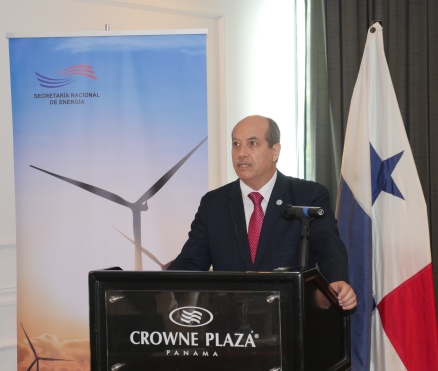
Water and energy are essential for human welfare and sustainable development. The interactions between water and energy can improve or affect the quality of life of citizens of the Americas. With this premise in mind, the Organization of American States (OAS) held the “Regional Dialogue on water-energy nexus” on May 24-25. The event was co-hosted by the National Energy Secretariat (SNE), with the support of the Inter-American Development Bank (IDB), which main objective was to establish an inter-American cooperation framework that encourages an integrated management of water resources and energy in the Americas.
 Pedro Vuscovic, OAS Country Representative in Panama, offered opening remarks to more than 40 attendees, stated “climate change is one of the main determinants of water availability, being imperative to pay special attention to the management of the water-energy connection, review current guidelines, and make adjustments if necessary.”
Pedro Vuscovic, OAS Country Representative in Panama, offered opening remarks to more than 40 attendees, stated “climate change is one of the main determinants of water availability, being imperative to pay special attention to the management of the water-energy connection, review current guidelines, and make adjustments if necessary.”
Dr. Victor Carlos Urrutia, National Secretary of Energy, also present at the opening session, took this opportunity to reaffirm the interest of the National Government to move towards a more integrated and efficient water and energy management, fundamental resources for development and human well-being for his country. “This dialogue will address common issues in water and energy systems, the basic elements required to improve and ensure both resources, and share concrete Latin American examples,” added Secretary Urrutia.
 During her speech, the Minister of Environment of Panama, Mrs. Mirei Endara, said that currently 23 percent of the total water use is committed to the generation of electricity, making the sector the largest consumer of water. “According to the National Energy Plan, we currently consume about 10 thousand GigaWatts (GW) of electricity, out of which 70 percent comes from water sources. This figure will reach 31,000 kilowatts by 2050,”” added Minister Endara.
During her speech, the Minister of Environment of Panama, Mrs. Mirei Endara, said that currently 23 percent of the total water use is committed to the generation of electricity, making the sector the largest consumer of water. “According to the National Energy Plan, we currently consume about 10 thousand GigaWatts (GW) of electricity, out of which 70 percent comes from water sources. This figure will reach 31,000 kilowatts by 2050,”” added Minister Endara.
From the hemispheric water resources perspective, the discussed issues illustrated a picture of an overdue recognition of its importance. The topics that received the most attention were the negative impact and the detriment of ecosystems caused by the overuse of natural resources, the high number of people still living with limited or no access to basic water and electricity in the region, and the difficulties that governments and society have to face overcoming damages associated with natural disasters due to their complex nature.
As for the hemispheric energy outlook, the initial point of discussion was how water availability affects power generation, putting the sector in a vulnerable position, given the rising water scarcity and therefore, increasingly becoming a determinant criteria for assessing the physical, economic and environmental feasibility for advancing energy projects. Moreover, the urgency to address the nexus in a more comprehensive and effective manner considering factors such as climate change, population growth and migration flows, and new technologies for energy generation, water management and energy efficiency was reaffirmed.
Another issue that received special attention was the need to develop coordinated policies to address water and energy in a more comprehensive manner. The key elements analyzed for the development of sound water-energy policies, were governance strengthening through better coordination and inter-sectorial planning, a more robust role of the state, expand and modernize the measuring network and introduce new technologies, emphasize the economic value of water, and promote rational use and energy efficiency.
The water-energy nexus was also analyzed from other contexts and sectors, including energy integration, where the SIEPAC model system is optimizing the use of water resources dedicated to power generation. In fact, several actors using different resources for electricity generation contribute to supply all consumers in a particular geographic area, in order to establish a regional energy market.
From the Central American industry context, the need to foster a regional position on energy issues aimed at strengthening the sector centring on the development of the energy sector, and promoting free competition in the electricity market was expressed. Harnessing energy alternative sources such as natural gas, and stimulating incentives for the business sector to invest in energy efficiency, in the absence of ‘coercive’ measures imposed by the government. Comments regarding the great difficulty for identifying opportunities for private sector collaboration to promote rational use of water also arose during the conversation.
Additionally, the water-energy nexus was analyzed from the port sector, since nearly 90 percent of the world trade merchandise is moved by sea. In this context, energy efficiency is set as one of the fundamental pillars in present and future ports that will facilitate the achievement of sustainability, and is proposed as a measure to reduce costs and shipping carbon footprint.
The need to pay greater attention to the social conflicts that arise from the increasing demand to water and energy access was also mentioned. It is a concern that requires a greater, more active citizen participation and effective communication among different sectors.
The Regional Dialogue on water-energy nexus was an activity carried out under the Energy and Climate Partnership of the Americas (ECPA). A hemispheric initiative aimed at facilitating dialogue on sustainable energy and climate change. This meeting originated from a conversation held between the secretaries of energy of Panama, Mexico and the United States that took place during the Second ECPA ministerial meeting convened in Merida in May 2015.
 View Map
View Map